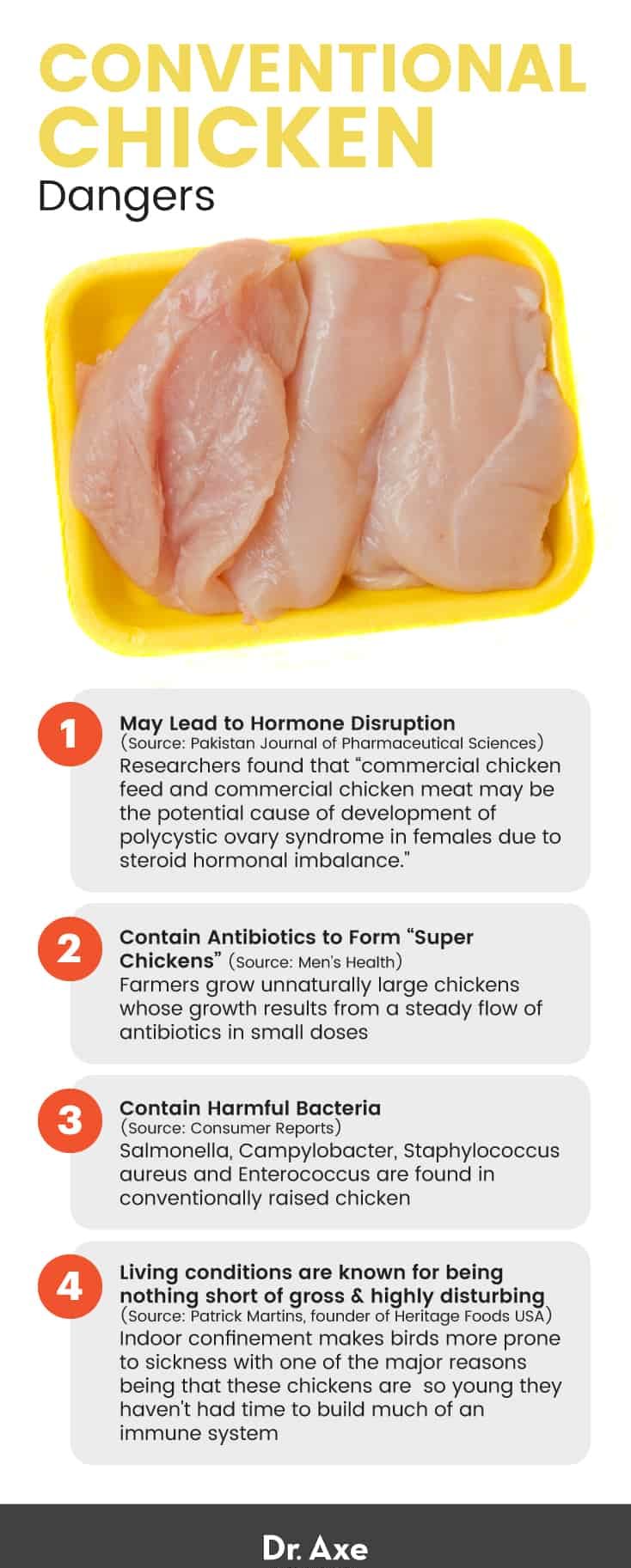This Dr. Axe content is medically reviewed or fact checked to ensure factually accurate information.
With strict editorial sourcing guidelines, we only link to academic research institutions, reputable media sites and, when research is available, medically peer-reviewed studies. Note that the numbers in parentheses (1, 2, etc.) are clickable links to these studies.
The information in our articles is NOT intended to replace a one-on-one relationship with a qualified health care professional and is not intended as medical advice.
This article is based on scientific evidence, written by experts and fact checked by our trained editorial staff. Note that the numbers in parentheses (1, 2, etc.) are clickable links to medically peer-reviewed studies.
Our team includes licensed nutritionists and dietitians, certified health education specialists, as well as certified strength and conditioning specialists, personal trainers and corrective exercise specialists. Our team aims to be not only thorough with its research, but also objective and unbiased.
The information in our articles is NOT intended to replace a one-on-one relationship with a qualified health care professional and is not intended as medical advice.
Free-Range Chicken Benefits vs. Conventional Chicken Concerns
August 2, 2023

If you’re not a vegetarian or vegan, you probably eat chicken, but what kind of chicken do you eat: conventional or free-range chicken?
These days not all chicken farms are created equal. In fact, some of these places treat their birds poorly and produce some low-quality chicken meat — and quality isn’t the only issue. Conventional chicken meat has been found to contain some seriously unwanted pathogens, such as Salmonella.
That’s why free-range chicken is the only way to go when you consume this common high-protein food.
If you’re going to choose chicken as a protein source in your diet, you want to make sure that it’s both organic and free-range.
Let’s talk about why free-range chicken is so important for both chickens and chicken consumers. Also, maybe you’re interested in raising your own free-range chickens so I’ll touch on how you can raise them in your own backyard as well.
What Does ‘Free Range’ Mean?
To define chicken, a chicken belongs to the poultry family, which is a group of domesticated birds, including chickens, turkeys and ducks, that are commonly raised by humans for their eggs and meat — along with the nutrients in chicken, such as chicken collagen.
What does free-range chicken mean exactly? The U.S. Department of Agriculture (USDA) defines free-range chickens as chicken that come from producers who demonstrate that their chickens have been allowed access to the outside.
“Free roaming” is another common term used interchangeably with free range. Typically, chickens that are raised using free-range methods have continuous access to the outdoors for more than 51 percent of their lives.
Free-range chickens are able to roam around, get fresh air and sunshine, and have contact with other chickens. However, since the USDA’s definition of free range is pretty general, it’s a good idea to look into exactly how “free range” a company’s chickens really are since legally the term can just mean that chickens have access to the outside.
Ideally, you want free range to mean that the chickens are truly roaming free around a pasture, not just getting outside once in a while.
If free-range chickens spend most of their time roaming around, where do they lay their eggs? That answer can definitely vary depending upon the setup of the specific chicken farm raising the chickens and also the chicken itself.
Some free-range chickens have been known to lay their eggs in the coop or nest boxes. However, some hens go rogue, and you may not know where they laid their eggs until you stumble upon them.
You also may know when and where a hen is laying her eggs because she may likely make a lot of noise when she is laying them, which is sometimes called the “egg song.”
When shopping for chicken, you want to first make sure it’s certified organic and then that it was raised under truly free-range conditions. This is when a local source can really be the best way to guarantee that both are true when it comes to your chicken meat as well as your eggs.
I also want to note the difference between cage-free vs. free-range eggs: Cage-free eggs come from a hen that had more room than a caged chicken, but it still was not necessarily allowed to go outdoors like a free-range hen.
Benefits of Free-Range Chicken
1. Great Protein Source
One of the healthiest things about free-range chicken is its high protein content.
Protein is so crucial to the health of our bodies. It’s so crucial, in fact, that it’s even referred to as “the building block of life.”
When you don’t get an adequate amount of protein in your diet, your cells can have a much harder time growing and repairing themselves than they should. For growing kids and pregnant mothers with growing babies, protein is especially vital.
2. Free-Range Chickens Make Healthier Eggs
Free-range chickens are known for producing eggs that are much more nutritionally dense than the eggs laid by caged hens.
According to one study conducted in 2007, free-range eggs are a much healthier choice in a lot of specific ways. This study showed that compared to eggs from battery-caged hens, eggs from free-range hens contained:
- ⅓ less cholesterol
- ¼ less saturated fat
- ⅔ more vitamin A
- 2 times more omega-3
- 3 times more vitamin E
- 7 times more beta-carotene

3. Conventional Chicken Linked to Hormone Disruption
A scientific study published in 2017 looked at the effects of feeding commercial chicken feed, conventional chicken meat or organic chicken meat to groups of female animal subjects. To evaluate the effects, researchers took measurements of the subjects’ percent growth rate and cholesterol levels as well as their progesterone, testosterone and estrogen levels.
What did they find? Consuming both commercial chicken feed and commercial chicken meat resulted in increases in growth, increases in cholesterol levels and an imbalance in hormone levels.
Overall, the study concludes that “commercial chicken feed and commercial chicken meat may be the potential cause of development of polycystic ovary syndrome in females due to steroid hormonal imbalance.”
4. Free Range May Taste Better
Many people find organic free-range chicken to be tastier than conventional chicken. One possible reason that organic free-range chickens may taste better is that they eat a higher quality diet than conventional birds.
A study published in the journal Poultry Science divided 600 chickens into three groups: those raised completely indoors, those given outdoor access with artificial shelters and those given outdoor conditions shaded by willow trees. Researchers found that the birds that had outdoor access and natural shelter had juicier, more tender and better textured meat.
The researchers believe that the amount of exercise free-range chickens are able to get on a daily basis helps develop their muscles, which results in better flavor and texture.
Conventional Chicken Concerns
Chicken is a very popular source of protein. Chicken farmers in the United State sell more than 8 billion birds for meat each year.
So what is so concerning about conventional chicken meat?
For starters, the way conventional chickens are raised has really gone downhill in the 20th century when factory farming began. Not only did chickens stop having outdoor access, but they began living in very confined conditions and started being pumped with antibiotics.
These days, companies that produce conventional chicken meat are getting the meat from what is now being referred to as “super chickens.” These are are unnaturally large chickens whose growth results from a steady flow of antibiotics in small doses.
In 2013, Consumer Reports conducted some highly revealing testing of chicken meat. It purchased 316 raw chicken breasts from various retailers around the country and found that a whopping 97 percent contained potentially harmful bacteria, including Salmonella, Campylobacter, Staphylococcus aureus and Enterococcus.
Approximately half of the chicken tested also contained at least one bacterium resistant to three or more antibiotics, which means it is a multidrug-resistant bacteria or “superbug.” In addition, more than 11 percent contained two or more of these superbugs!
It’s not very surprising that when you put animals of any kind indoors in very tight spaces in high numbers, the areas that these animals live in becoming very unhealthy very fast. For many conventionally raised chickens, living conditions are known for being nothing short of gross and highly disturbing.
Patrick Martins, founder of Heritage Foods USA, says that indoor confinement makes birds more prone to sickness with one of the major reasons being that these chickens are so young they haven’t had time to build much of an immune system. Martins also points out that while conventional poultry farmers may say that outdoor free ranging increases a chicken’s likelihood of being exposed to pathogens, he suggests that this viewpoint makes it seem as though “biodiversity is a threat; they’re saying the opposite of what is true.”
A free-range chicken quite clearly lives an overall healthier lifestyle.
Free-Range vs. Organic vs. Conventional
Free-range chicken is not necessarily organic, but organic chicken is basically required to be raised in a free-range manner. Organic chickens can only eat certified organic feed and aren’t allowed be given antibiotics or hormones, but they are permitted to receive preventative vaccines.
Organic chickens must have “the opportunity for exercise, freedom of movement, and reduction of stress.”
What about free-range chickens? By USDA standards, they have be able to go outdoors for some amount of time.
Organic and free-range chickens often have access to a pasture, and to define pasture, it’s typically a plot of land with nice green grass for grazing.
The majority of conventional chicken comes from factory farms. This means that the chickens are packed into cages, which leads to unsanitary and unhealthy conditions very quickly.
The confinement also means that these chickens are more likely to get sick, which is why the majority of conventional chickens are pumped with antibiotics for most, if not all, of their lives. These antibiotics don’t go away and can still be found in the conventional chicken meat offered at supermarkets, restaurants and fast food chains.
Conventional chickens are most often raised in cages. If the chickens are egg-laying hens, then these cages usually contain six chickens with each one getting a mere 67 square inches of space — or sometimes even less.
Conventional chickens do not typically get to go outside at all. There is absolutely zero roaming or free-range time outdoors or indoors.
Chicken antibiotics are commonly given to these conventional birds due to all of the sicknesses that occur in them due to the close living quarters.
Here are the meanings of some other common store-bought chicken terms:
- “Fresh” means the chicken has never been cooled below 26 degrees F or -3 degrees C.
- “Natural” should mean that the chicken does not contain any preservatives or artificial ingredients. Most chicken sold in stores can easily make this claim since it just means that there’s no artificial ingredients or preservatives added to the meat.
- “Farm raised” really doesn’t mean anything since pretty much every single chicken is raised on a farm of some sort.
- “Hormone-free” can be meaningful for other meats but not chicken since poultry legally cannot contain hormones.
- “Antibiotic-free” does mean something since conventional chickens are commonly given antibiotics, but organic chickens are not allowed to be given antibiotics.

Raising Free-Range Chickens
Some of the most popular questions when it comes to raising your own free-range chickens include: How much does a free-range chicken cost, and do free-range chickens need feed?
Prices of chickens vary, but one chicken raiser living outside of Cleveland provides his example of spending $3.60 on one heritage breed chick purchased online and shipped to his local post office.
What about feed? Free-range chickens typically consume high-quality chicken feed in addition to what they find to eat on their own.
If you’re wondering how to raise free-range chickens in your own backyard, here are some helpful resources:
- Raising Free-Range Chickens
- How to Raise Free Range Chickens
- How to Free Range Chickens with Supervision
How to Use and Cook (Recipes)
Where can you buy free-range chicken? If you have a local farm or farmers market, then getting free-range chicken from a supplier close to your home is always a great way to go.
With a locally sourced free-range chicken, you are likely to get much fresher meat. Plus, you may even be able to visit the farm and see exactly how the chickens live on a daily basis.
Health stores that carry chicken products typically only carry chicken that is organic or organic and free-range. Nowadays, it’s also easy to find free-range chicken in your grocery store. With all the issues with conventional chicken, it has definitely become easier to find free-range and organic chicken in a lot more locations.
Free-range chicken can be baked, broiled, roasted and stir-fried. It can be eaten alone or added to salads, soups or stews.
Chicken is also a great protein-rich addition to noodle, rice and vegetable dishes. It’s most often used as a main course, but it can also make a great snack.
Raw chicken must always be handled with great care since it can carry harmful bacteria. According to the USDA’s Food Safety and Inspection Service (FSIS), a whole chicken should be cooked to a safe minimum internal temperature of 165 degrees F or 73.9 degrees C. This safe internal temperature should be measured using a food thermometer placed in the innermost part of the thigh and wing and the thickest part of the breast.
You can also choose to cook poultry to a higher internal temperature.
For more specifics on cooking different parts of chicken in different ways, check out this FSIS chart.
Any recipe that calls for chicken is a candidate for the use of free-range chicken.
Here are some super tasty and healthy recipes where free-range chicken can be the star:
- Chicken Tikka Masala Recipe
- Chicken Bryan Recipe
- Chicken Bone Broth Recipe
- Garlic Baked Chicken Recipe
If none of those get your mouth watering, you can also check out 25 Crockpot Chicken Recipes for Easy, Delicious Meals or Snacks.
Risks and Side Effects
It is possible to have an allergy to chicken meat. Do not consume free-range chicken if you have a chicken allergy. If you do have a chicken allergy, you are likely to react to not only cooked chicken meat, but also to raw meat, live chickens and chicken feathers.
An allergy to chickens is not common, but if you are allergic symptoms can range from mild to serious and can include:
- itchy, watery or swollen eyes
- a runny, itchy nose
- sneezing
- scratchy, sore throat
- coughing or wheezing
- trouble breathing
- irritated or itchy skin
- an eczema-like rash
- hives
- nausea
- stomach cramps
- vomiting
- diarrhea
- anaphylaxis
Chicken allergy symptoms can occur immediately once exposed to chicken, or they may not show up until hours later. Seek medical attention if needed.
Final Thoughts
The old saying “you are what you eat” applies to both the chicken and the human consuming the chicken. After reading this article, I’m sure you can see why you may want to strongly consider switching from conventional chicken meat to organic, free-range chicken meat.
Not only do free-range chickens lead much happier and healthier lives, but they also produce meat that is much healthier and, a lot of times, tastier too.













